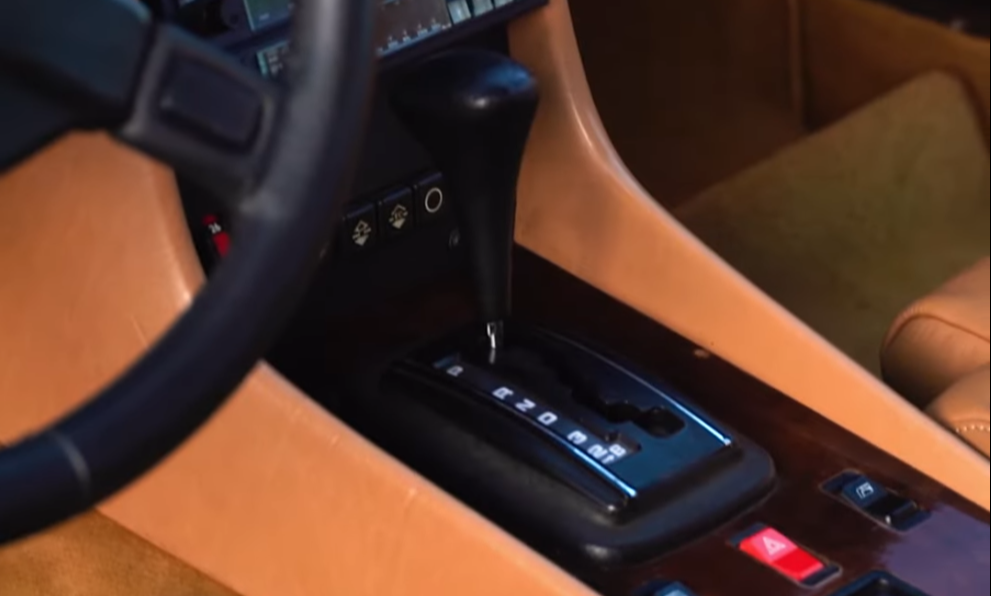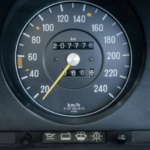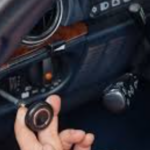The automatic transmission in the Mercedes-Benz R107 is designed to provide smooth gear changes, optimal performance, and driving comfort. Proper understanding and use of the transmission not only enhances driving pleasure but also extends the lifespan of the transmission components.
This guide covers essential functions, best practices, safety precautions, and tips for maneuvering, stopping, and using cruise control.
1. Understanding the Automatic Transmission
Unlike a manual transmission, the automatic transmission in the R107 selects gears based on throttle input, vehicle speed, and road conditions. However, the driver can still influence gear selection through the selector lever positions and accelerator input.
How It Works:
- Partial throttle: The transmission shifts early, promoting fuel efficiency and smoother driving.
- Full throttle: The transmission delays upshifting, maximizing acceleration.
- Kickdown mode: Pressing the accelerator beyond full throttle causes the transmission to downshift to a lower gear, providing extra power for overtaking.
Safety Note:
⚠️ Always keep the driver’s foot area clear. Objects near the pedals can interfere with braking and acceleration, causing dangerous driving conditions.
2. Selector Lever Positions and Their Functions
The selector lever allows the driver to choose between fully automatic or manually controlled gear ranges.

| Position | Function |
|---|---|
| P (Park) | Engages the parking lock. Always engage when parked. |
| R (Reverse) | Activates reverse gear. Shift only when the car is completely stopped. |
| N (Neutral) | Disengages the transmission, allowing the car to roll freely. Use when pushing or towing. |
| D (Drive) | The fully automatic mode upshifts to top gear for normal driving. |
| 3 | Limits upshifting to third gear only—ideal for hilly terrain and moderate slopes. |
| 2 | Limits upshifting to second gear only, providing engine braking on steep descents. |
| B (Brake Mode) | Maximizes engine braking when going downhill at speeds below 40 mph (60 km/h). |
Important Tips for Gear Selection
✅ Do not shift into “P” or “R” while the vehicle is moving. This can cause severe transmission damage.
✅ Do not engage “N” while driving, except in emergencies (e.g., loss of traction on icy roads).
✅ Use “2” or “B” on long downhill stretches to avoid excessive brake wear.
3. Best Practices for Driving with an Automatic Transmission
Starting and Moving Off
✔ Shift into “D” or “R” only when the engine is idling and the brake is applied.
✔ Do not release the brake until ready to move. The car may creep forward or backward when in gear.
Braking and Stopping
✔ For short stops (e.g., traffic lights), leave the transmission in “D”.
✔ For longer stops (e.g., traffic jams), shift into “N” or “P”.
✔ On hills, never use the accelerator to hold the car. Use the brake to prevent transmission overheating.
Maneuvering in Tight Spaces
✔ Use the brake to control speed, not the accelerator.
✔ Avoid aggressive accelerator inputs when parking or moving in confined areas.
Driving on Slippery Roads
✔ Avoid sudden downshifts on wet or icy surfaces to prevent loss of traction.
✔ Do not allow one wheel to spin excessively when starting on a slippery surface.
Towing and Uphill Driving
✔ When climbing steep hills, use “3” or “2” to keep the engine in its optimal torque range.
✔ Do not let the engine labor—downshift early to maintain a steady speed.
4. Cruise Control Operation

The R107 is equipped with cruise control, allowing the vehicle to maintain a constant speed above 25 mph (40 km/h).
Using Cruise Control
| Function | Action |
|---|---|
| (1) Set/Accelerate | Lift the cruise control lever briefly to set speed. Hold it up to accelerate. |
| (2) Reduce Speed | Press the lever down briefly to lower speed. Hold it down to decelerate. |
| (3) Cancel Cruise Control | Tap the brake pedal or push the cruise lever toward neutral. |
Safety Tips for Cruise Control
⚠️ Do not use cruise control on slippery roads—sudden acceleration can cause loss of traction.
⚠️ Be prepared to deactivate cruise control if traffic conditions change suddenly.
5. Common Transmission Issues & Troubleshooting
Delayed Shifting or Slipping Gears
🚨 Possible Causes:
- Low transmission fluid level
- Worn clutch packs
- Faulty vacuum modulator
✅ Solution:
- Check and top off ATF (Automatic Transmission Fluid) with MB-approved fluid.
- Visit a transmission specialist if slipping persists.
Hard or Jerky Shifts
🚨 Possible Causes:
- Worn transmission mounts
- Incorrect kickdown cable adjustment
✅ Solution:
- Inspect and replace worn mounts.
- Adjust the throttle and kickdown cables.
Overheating Transmission
🚨 Possible Causes:
- Continuously driving in high gear on steep inclines
- Holding the vehicle with the accelerator on a hill
✅ Solution:
- Use lower gears (“2” or “B”) on long downgrades.
- Let the transmission cool down before driving again.
Conclusion
The automatic transmission in the Mercedes-Benz R107 is durable, reliable, and efficient when used correctly. By following these best practices, safety precautions, and troubleshooting tips, you can maximize performance and prolong the lifespan of your transmission.
🔧 Regular maintenance, fluid checks, and proper driving techniques are key to keeping your classic Mercedes in top condition!



